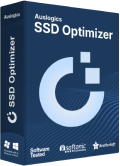Technical Support for SSD Optimizer
-
Why is optimizing SSDs important?
Optimizing SSDs improves performance by reducing the number of input/output operations, extends SSD lifespan by cutting down unnecessary writes, and efficiently organizes disk space, ensuring smoother system operation.
-
What is Auslogics SSD Optimizer, and how can it benefit my PC?
Auslogics SSD Optimizer is a specialized tool crafted to enhance the efficiency of your SSD and boost its performance. The tool is solely focusing on SSD management, ensuring optimized functionality tailored to your SSD's needs, excluding unnecessary HDD-related features.
-
Is Auslogics SSD Optimizer free?
Yes, SSD Optimizer can be downloaded for free, offering basic optimization features. However, to unlock the full range of optimization capabilities, users have the option to purchase the Pro version. This ensures access to advanced features for maximizing SSD performance and lifespan.
-
Which Windows versions does Auslogics SSD Optimizer support? Does it work with 64-bit and 32-bit processors?
Auslogics SSD Optimizer supports the following Windows versions:
- Windows 7 (32-bit and 64-bit)
- Windows 8 (32-bit and 64-bit)
- Windows 8.1 (32-bit and 64-bit)
- Windows 10 (32-bit and 64-bit)
- Windows 11
It does not support Windows 2000, 95, 98, 98SE, ME, XP, or Vista.
There are no Mac or Linux versions.
If you haven't found the answer you are looking for, please fill out this contact form with your question and we will reply to you shortly.
-
Why are there two separate tools for HDDs and SSDs now?
Splitting into two distinct tools, Auslogics Disk Defrag and Auslogics SSD Optimizer, provides dedicated solutions for each drive type, tailored to the specific requirements of HDDs and SSDs, respectively. Users no longer need to navigate through features irrelevant to their drive type, which enhances usability and efficiency.
-
What if I have both an HDD and an SSD?
If you have both HDD and SSD drives, Auslogics offers the Disk Toolkit bundle, specially designed for users with both drive types. This bundle comes at a special price and provides comprehensive optimization solutions for both HDDs and SSDs.
-
Can I optimize large disks of several terabytes?
Yes. SSD Optimizer is equipped with a powerful engine that allows optimizing multi-terabyte drives.
-
Can I optimize RAID?
Auslogics SSD Optimizer works well for RAID disks too. The RAID controller still presents the RAID disks as NTFS storage to the file system, and therefore SSD Optimizer will not do anything differently for RAID arrays.
-
What’s the difference between “Wipe Free Space” and “Disk Cleanup” modes?
The Wipe Free Space tool wipes traces of previously deleted files that are still there on your drives to prevent unauthorized recovery of any confidential data you may have deleted.
Disk Cleanup clears temporary system files that are no longer needed for normal system operation. This helps free up disk space and reduce the amount of data that may need to be scanned and processed by the program during optimization.
-
Why are some of the files skipped by the program?
Some OS files may be locked by the operating system and may not be processed under normal conditions. SSD Optimizer will skip these files during optimization.
-
Does SSD Optimizer support command line?
Yes, the command line tool is called “cssdoptimizer.exe” and can be found in the program folder once you download and install SSD Optimizer. Please see this page for the full list of command line parameters.
-
Does SSD Optimizer provide real-time drive health monitoring?
SSD Optimizer comes with a new feature—the Statistics tab. It allows you to:
- View detailed information about your storage device, including some technical specifications (SSD, HDD).
- Access the data on the current temperature and the device’s temperature conditions (SSD, HDD).
- Check disk reliability and health parameters (SSD, HDD).
- Monitor current operating parameters.
- Review power consumption modes (for NVMe SSDs).
- See the amount of data written to your SSD over various time periods (current and previous day, week, month, year). This helps visually assess SSD wear and see what might be causing it the most and when.
- Get an estimated forecast of your SSD’s remaining lifespan.
-
Does SSD Optimizer offer automated optimization schedules?
Yes, SSD Optimizer allows you to run automated optimization on a schedule. You can configure the frequency (when your PC is idle for a specified period, daily, weekly, or monthly), choose which drives to optimize, and customize additional options. The feature is available in the Pro version of SSD Optimizer.
-
Are there any rollback options in case optimization procedures fail?
All optimization operations are protected against failure. In case of a failure during the optimization process, no data will be lost. When moving data blocks, the Copy-On-Write algorithm is used, meaning the data is first copied, and only after the successful copying it gets marked as deleted. If a failure occurs during copying, the original data remains available and unchanged.
-
How can I find out what type of disk drives are installed in my system – HDD or SSD?
Auslogics SSD Optimizer automatically detects whether your disk is an HDD or SSD and marks the type in the corresponding column of the Disk List table. This way, you don’t have to worry about looking up your PC properties and trying to find your drive characteristics on your own.
If SSD Optimizer detects that all of your drives are HDD, it will not run SSD optimization on them. If that’s the case on your PC, we recommend that you install Auslogics Disk Defrag and use its fast defragmentation engine to maintain your drives.
![[Full Review] The Best Driver Updater Tools for Windows PCs in 2025](/en/articles/wp-content/uploads/2025/04/ChatGPT-Image-Apr-18-2025-at-11_00_25-AM-2.webp)

![[SOLVED] PC Randomly Turns Off—What to Do?](/en/articles/wp-content/uploads/2025/04/SOLVED-PC-Randomly-Turns-Off—What-to-Do.webp)










 Download
Download